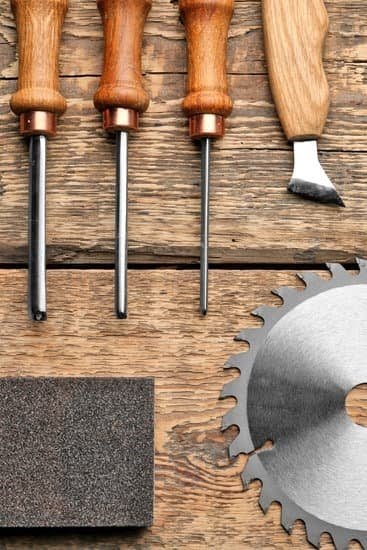A woodworking shaper is a versatile and essential tool for any woodworker, offering the ability to create intricate shapes, profiles, and joints with precision and ease. Whether you’re a professional craftsman or a DIY enthusiast, understanding how to use a woodworking shaper can greatly enhance your woodworking projects.
In this article, we will guide you through the process of using a woodworking shaper step-by-step, from understanding its basic components to exploring advanced techniques and troubleshooting common issues. By the end of this article, you will have the knowledge and confidence to effectively utilize this powerful tool in your woodworking endeavors.
A woodworking shaper consists of several key components that work together to shape wood according to your desired specifications. Understanding these parts is essential before diving into using the tool itself.
From the motor that powers the cutter head to the fences that guide and support the workpiece, each component plays a crucial role in achieving accurate and consistent results. We will break down these components in detail in the following section, providing you with a solid foundation for operating your woodworking shaper.
Safety should always be your top priority when working with any power tool, including a woodworking shaper. Before we delve into using this tool, we will emphasize the importance of taking proper safety precautions. This includes wearing appropriate protective gear such as safety goggles and hearing protection, as well as securing your workpiece firmly in place. Following these safety guidelines will ensure not only your well-being but also produce high-quality woodworking projects.
As we explore further in this article, we will cover topics such as selecting the right shaper for your needs, setting it up correctly, operating it effectively, implementing advanced techniques for more intricate designs, maintaining its optimal performance level over time, and troubleshooting any issues that may arise along the way.
So let’s get started on our journey to unlock the full potential of your woodworking shaper and take your craftmanship to new heights.
Understanding the Basics
A woodworking shaper is a versatile tool that can greatly enhance your woodworking projects. Before using a shaper, it’s important to understand its basic components and how they work together to shape wood. This section will break down the different parts of a woodworking shaper, including the motor, cutter head, and fences.
1. Motor: The motor is the heart of a woodworking shaper. It provides the power needed to rotate the cutter head and shape the wood. When selecting a shaper, consider the horsepower (HP) rating of the motor. Higher HP ratings generally indicate more power and better performance.
2. Cutter Head: The cutter head is responsible for cutting and shaping the wood. It typically consists of multiple blades or cutters that are mounted on a spindle. The cutter head can be categorized into two types – straight knives and insert cutters. Straight knives are made of high-speed steel (HSS) or carbide and require sharpening when dull. Insert cutters have small replaceable inserts that can be easily rotated or replaced when worn out.
3. Fences: Fences play an important role in guiding the workpiece during shaping operations. They help ensure accurate cuts and consistent results by providing support and stability to the workpiece.
There are two main types of fences – adjustable fences and split fences. Adjustable fences can be moved closer or further away from the cutter head, allowing for different positioning options based on your desired cuts. Split fences have two adjustable sections that can be independently set at different distances from the cutter head, which allows you to create complex moldings with multiple profiles.
Understanding these basic components of a woodworking shaper is essential for effectively using this tool in your woodworking projects. By familiarizing yourself with how each part works, you’ll be able to make informed decisions when selecting a shaper for your needs and confidently operate it for various shaping operations.
Safety First
Woodworking shapers are powerful tools that require careful attention to safety precautions before operation. Regardless of your skill level, it is crucial to prioritize safety to prevent accidents and injuries. This section will discuss the essential safety precautions one must take before operating a woodworking shaper, such as wearing protective gear and properly securing the workpiece.
1. Wear Protective Gear: When operating a woodworking shaper, it is vital to wear appropriate protective gear to safeguard yourself from potential hazards. Always wear safety glasses or goggles to protect your eyes from flying debris. Additionally, using hearing protection can help minimize the noise produced by the tool. It is also recommended to wear a dust mask or respirator to avoid inhaling fine particles and sawdust.
2. Secure the Workpiece: Before starting any woodworking project on a shaper, ensure that the workpiece is securely fastened in place. Using a combination of clamps, hold-downs, and featherboards can help prevent the workpiece from shifting or bouncing during operation, reducing the risk of accidents. Make sure that the workpiece is properly aligned with the fence and cutter head for accurate and safe cuts.
3. Familiarize Yourself with Emergency Stop Features: Most woodworking shapers are equipped with emergency stop features such as a large red button or paddle switch. It is crucial to familiarize yourself with these features before operating the tool and understand how they function in case of an emergency.
4. Maintain a Clear Workspace: Ensure that your workspace is clean and clutter-free before using a woodworking shaper. Remove any unnecessary objects or tools from the area surrounding the machine to avoid interference during operation. Also, keep in mind that loose clothing, jewelry, or long hair can become entangled in moving parts of the tool-always secure loose items and tie back long hair.
By following these essential safety precautions before operating a woodworking shaper, you can mitigate risks and work confidently on your projects. Remember that safety should always be a priority, and it is crucial to read the manufacturer’s instructions and guidelines for your specific woodworking shaper model.
Choosing the Right Shaper
Exploring the different types of woodworking shapers available in the market is essential when considering purchasing one for your woodworking projects. The right shaper can greatly enhance your woodworking experience and improve the quality of your finished products. Here, we will discuss the various types of shapers and provide tips on selecting the most suitable one based on your needs and projects.
When choosing a woodworking shaper, it is important to consider factors such as the size and power of the machine, as well as its versatility and intended use. There are primarily two types of shapers available: spindle shapers and router shapers.
Spindle shapers are larger machines that typically have more power and are ideal for heavy-duty cutting tasks. They feature a vertically-mounted spindle that holds the cutter head, allowing for precision shaping and profiling. Spindle shapers are commonly used in professional woodworking shops or by experienced woodworkers who require high-quality finishes and intricate shaping capabilities.
On the other hand, router shapers are smaller and more versatile machines that use a horizontally-mounted motor with interchangeable bits or cutters. These machines are suitable for both small-scale hobbyist projects and professional applications. The advantage of router shapers lies in their ability to quickly switch between different profiles or styles with ease, making them more convenient for those who work on varying projects or require frequent tool changes.
When selecting a woodworking shaper, it is important to determine your specific needs and project requirements. Consider factors such as budget, available workspace, desired cutting capacity, and versatility. Additionally, it is crucial to understand your skill level and experience in using these machines.
In summary, choosing the right woodworking shaper requires careful consideration of factors such as size, power, versatility, intended use, budget, workspace availability, and personal skill level. By understanding the differences between spindle shapers and router shapers along with their features and limitations, you can make an informed decision that will best suit your needs and enhance your woodworking projects.
| Type of Shaper | Description | Suitability |
|---|---|---|
| Spindle Shaper | Larger machine with vertically-mounted spindle for precision shaping and profiling. Suitable for heavy-duty cutting tasks. | Ideal for professional woodworking shops or experienced woodworkers who require high-quality finishes and intricate shaping capabilities. |
| Router Shaper | Smaller and more versatile machine that uses a horizontally-mounted motor with interchangeable bits or cutters. Can quickly switch between different profiles or styles. | Suitable for both small-scale hobbyist projects and professional applications, convenient for those who work on varying projects or require frequent tool changes. |
Setting Up Your Woodworking Shaper
Setting up a woodworking shaper properly is crucial for achieving accurate and precise results in your woodworking projects. By following step-by-step instructions, you can easily assemble and prepare your woodworking shaper for use. Here are the key steps to setting up your woodworking shaper:
- Adjusting the Fence: The fence plays a vital role in guiding the workpiece during shaping. Start by loosening any locking knobs or screws that secure the fence in place. Position the fence at the desired angle relative to the cutter head, ensuring it is parallel to the miter slot or table surface. Once aligned, tighten the locking knobs or screws to secure the fence firmly in place.
- Installing the Cutter Head: The cutter head is responsible for shaping and cutting the wood. Begin by removing any tooling that was previously installed on the spindle, if applicable. Choose an appropriate cutter head based on your intended project and attach it securely onto the spindle by following specific manufacturer instructions. Make sure it is centered and tightened properly.
- Aligning the Motor: Proper alignment of the motor ensures smooth operation and prolongs its lifespan. Consult your woodworking shaper’s manual to locate adjustment screws or bolts that allow you to align the motor vertically and horizontally. Use a reliable level or straightedge to check if it is parallel with both a flat reference surface (such as a table) and perpendicular to it (like a miter slot). Adjust as necessary until proper alignment is achieved.
By completing these steps, you can set up your woodworking shaper correctly and be ready to start shaping wood for your projects confidently.
NEXT STEPS: In order to make full use of your wooodworking equipment, such as making profiles or joinery cuts, refer to Chapter 7 of this guide – “Advanced Techniques”.
Operating the Woodworking Shaper
Feeding the Workpiece
One of the first things you need to know when operating a woodworking shaper is how to properly feed the workpiece. The key to a smooth and precise cut is maintaining a consistent feed rate. To do this, start by positioning yourself so that you are standing to the side of the machine, not directly in front of it. This will give you better control and visibility of the workpiece.
As you begin feeding the workpiece into the cutter head, make sure to apply steady pressure and avoid forcing it through. Let the shaper do the work for you. Keep your hands at a safe distance from the cutter head, using push sticks or push blocks when necessary to avoid any potential accidents.
Adjusting Depth of Cut
The depth of cut determines how much material will be removed with each pass. It’s important to adjust this according to your specific project requirements in order to achieve desired results. Most woodworking shapers have a depth adjustment feature that allows you to set the cutting depth accurately.
To adjust the depth of cut, start by turning off the shaper and unplugging it from the power source. Locate the depth adjustment knob or lever on your machine and loosen it. Then, raise or lower the cutter head until it reaches your desired cutting depth. Once set, tighten the adjustment knob securely before proceeding with operation.
Controlling Feed Rate
The feed rate refers to how quickly or slowly you guide the workpiece through the shaper. It’s important to find a balance between too fast and too slow, as both can result in subpar cuts. A general rule is that slower feed rates are ideal for denser materials like hardwoods, while faster feed rates can be used for softer woods.
Start by observing how your shaper handles different types of wood at various feed rates. Experiment with different feed rates until you find one that gives you the cleanest and smoothest cuts. Remember to always maintain control of the workpiece as you feed it through the shaper, using consistent pressure and guiding it steadily.
By mastering the feeding techniques, adjusting the depth of cut, and controlling the feed rate, you can use your woodworking shaper effectively and achieve professional-looking results in your projects. Practice these techniques while adhering to safety precautions to ensure a successful woodworking experience.
Advanced Techniques
Profile Creation:
One of the key advantages of using a woodworking shaper is the ability to create unique and decorative profiles on your wood pieces. Profiles add depth and character to your projects, making them stand out from the ordinary. To create different types of profiles with your woodworking shaper, you will need to use different types of cutters or knives.
There are various profile cutters available in the market, each designed for a specific profile shape. Some common profile shapes include ogee, roman ogee, cove, roundover, and chamfer. It is crucial to choose the appropriate cutter to achieve your desired profile.
When setting up your woodworking shaper for creating profiles, make sure to adjust the fence position accordingly to control the depth and width of your cuts. Additionally, take note of whether you need an inside or outside cut. An inside cut refers to removing material from the inside edge of the workpiece while an outside cut removes material from the outside edge.
Joinery:
Woodworking shapers can also be used for creating precise joinery joints such as dadoes and tenons. These joints play a significant role in constructing sturdy and durable furniture pieces.
Dadoes are wide grooves usually used for shelving in bookcases or cabinets. To create dadoes with your woodworking shaper, install a dado cutter head on the machine and adjust it according to the desired width and depth. Remember to always make multiple passes when cutting dadoes for accuracy.
Tenons are protruding sections on one piece that fit into corresponding mortises on another piece. They form strong connections between parts that can handle weight and stress well. To create tenons with a woodworking shaper, use a coping sled or tenoning jig for stability when working with smaller pieces. Carefully guide the wood across the cutter head to achieve a precise tenon.
Moldings:
Woodworking shapers are excellent for producing custom moldings that can add elegance and sophistication to your woodworking projects. By using different cutters or knives and adjusting the fence, you can create various types of moldings like baseboards, crown moldings, and decorative trims.
To create moldings, start with a thicker piece of stock and run it through the shaper multiple times, gradually removing material until you achieve the desired shape. It is important to maintain consistent pressure when feeding the workpiece to ensure an even profile along the entire length.
Remember to experiment with different cutters, techniques, and speeds to explore new possibilities for creating unique and intricate profiles, joinery joints, and moldings using your woodworking shaper. Practice on scrap wood before working on your actual project to gain confidence in mastering these advanced techniques.
Maintenance and Troubleshooting
Maintenance and Troubleshooting:
To keep your woodworking shaper in optimal condition and ensure its longevity, regular maintenance is crucial. Here are some essential maintenance tips to follow:
- Clean regularly: Dust and debris can accumulate inside the shaper, affecting its performance. After each use, make sure to clean the machine thoroughly using a brush or vacuum cleaner. Pay extra attention to areas such as the motor housing, cutter head, and dust collection ports.
- Lubrication: Proper lubrication of moving parts is necessary to reduce friction and prevent wear and tear. Refer to your manufacturer’s instructions on the specific lubricants recommended for your shaper. Apply lubricant to bearings, gears, and other relevant parts as per the guidelines provided.
- Check belts and pulleys: Over time, belts can stretch or become worn out. Inspect the belts for any signs of damage or excessive wear and replace them if necessary. Additionally, examine the pulleys for proper alignment and tension.
- Blade sharpening: The quality of your woodworking projects largely depends on a sharp cutter head blade. Regularly check the condition of your blades and sharpen or replace them as needed. Dull blades not only reduce efficiency but can also pose safety risks.
Along with regular maintenance, being aware of common issues that may arise during operation is important for troubleshooting purposes:
- Uneven cuts: If you notice that your cuts are coming out uneven or rough, it could be due to a misaligned fence or an improperly set depth of cut. Double-check these settings and readjust as necessary.
- Motor issues: If your shaper’s motor suddenly stops working or shows signs of decreased power output, it may be due to electrical problems such as loose connections or an overheating motor. Check all electrical connections and ensure proper ventilation around the motor.
- Vibrations: Excessive vibrations during operation can indicate a balance issue with the cutter head or an unbalanced workpiece. Check and balance the cutter head if necessary, and ensure that your workpiece is securely clamped or held in place.
Remember to always consult your shaper’s user manual for specific maintenance instructions and troubleshooting tips. By properly maintaining your woodworking shaper and promptly addressing any issues that arise, you can prolong its lifespan and continue enjoying the benefits it provides for years to come.
Safety Recap and Conclusion
Safety Recap and Conclusion:
Throughout this blog post, we have emphasized the importance of safety when using a woodworking shaper. It cannot be stressed enough how crucial it is to prioritize safety in any woodworking project. Before operating a woodworking shaper, always remember to wear protective gear such as safety goggles, ear protection, and gloves. Make sure to properly secure your workpiece using clamps or a vise and avoid loose-fitting clothing or jewelry that can get caught in the machinery.
Understanding the basics of a woodworking shaper is essential for safe and effective operation. Familiarize yourself with the different parts and components of a shaper, including the motor, cutter head, and fences. Choosing the right shaper for your needs is also important. Consider factors such as the power and speed requirements of your projects and select a shaper that meets those criteria.
Additionally, following the proper setup procedures for your woodworking shaper will ensure optimal performance. Adjusting the fence accurately, installing the cutter head securely, and aligning the motor correctly are all crucial steps in preparing your shaper for use. Once set up, operating the woodworking shaper requires careful attention to detail.
Always feed your workpiece against or parallel to the rotation of the cutter head and adjust the depth of cut according to your project requirements. Controlling the feed rate will help achieve smooth and clean cuts.
To enhance your woodworking skills even further, consider exploring advanced techniques with your woodworking shaper. Experiment with creating different types of profiles, joinery methods, and moldings to add unique features to your projects.
Lastly, regular maintenance is necessary to prolong the lifespan of your woodworking shaper. Clean it regularly after use and lubricate moving parts as needed. Additionally, familiarize yourself with common troubleshooting issues that may arise during operation so you can address them promptly.
In conclusion, by adhering to all safety precautions outlined in this blog post and utilizing our step-by-step guides, you can confidently use your woodworking shaper for future projects. Remember to prioritize safety at all times, carefully set up your shaper, and always follow proper techniques for operation. With practice and experience, you will be able to unlock the full potential of your woodworking shaper and create beautifully crafted pieces for years to come. Happy woodworking.

Hi everyone! I’m a woodworker and blogger, and this is my woodworking blog. In my blog, I share tips and tricks for woodworkers of all skill levels, as well as project ideas that you can try yourself.





